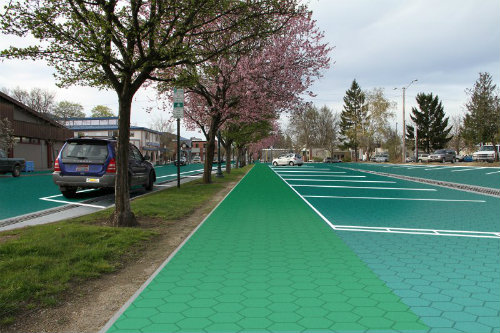A parking lot doesn’t normally generate attention, except when it’s covered in blue-and-green, hexagonal solar panels. Designed by Julie and Scott Brusaw, the panels may soon power America’s aging energy and road networks if the husband-and-wife team reach the $1 million goal of their Indiegogo campaign.

Concept image of solar roadways, by artists Craig Fine and Sam Cornett.
Launched last month, the campaign is the most recent phase of a multiyear effort from Idaho-based Solar Roadways, the startup founded by the Brusaws. The earliest iteration debuted in 2009, when the company received $100,000 from the Department of Energy to develop solar panels strong enough to withstand heavy vehicle loads and textured enough to provide the traction necessary to stop vehicles in emergency situations. Solar Roadways worked with researchers to then incorporate LED road markers and heating elements into the design, garnering along the way awards from various groups—winning GE’s Ecoimagination Challenge in 2011, for example—and funding from the US Federal Highway Administration.
Today Solar Roadways believes its prototype is ready for commercialization. The panels’ hexagonal design allows for better coverage on curves and hills, and the system can store, treat, and redistribute stormwater. The design also has provisions for power and data cables, thus eliminating the need for overhead power lines.
Scott Brusaw reports that the panels “prevented snow and ice accumulation this past winter and are producing the expected amount of power” or about a 3,600W solar array. That’s impressive, given that the US has more than 72,000 square kilometers of asphalt and concrete surfaces exposed to the sun.
“If we could cover them with our solar road panels,” says Brusaw, “then we could produce over three times the amount of energy that we use as a nation.”
If his forecast is correct, Solar Roadways’ invention could be revolutionary. “In the US, roughly half of greenhouse gases are generated by burning fossil fuels to create electricity. Another 25 percent comes out of our tailpipes,” Brusaw continues. “By replacing coal with solar and making electric vehicles practical—which could lead to the end of internal combustion engines—we could theoretically cut greenhouse gas emissions by up to 75 percent.”
The benefits seem clear, but the costs have yet to be calculated. Brusaw says the expenses associated with installing the panels are being drawn up and should be available in July. Solar Roadways is confident, however, that a commercialized solar roadway would produce enough power to pay for itself over its lifespan.
Until then, the Brusaws have little more than two weeks to meet their Indiegogo goal, which would allow them to hire others to help them fine-tune the design and streamline production. Solar Roadways hopes to be ready for production later this year.